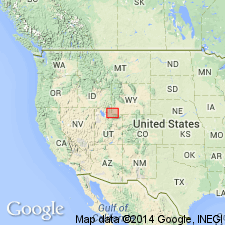
- Usage in publication:
-
- Weber Canyon Conglomerate
- Modifications:
-
- Named
- Dominant lithology:
-
- Conglomerate
- AAPG geologic province:
-
- Uinta uplift
Summary:
Named Weber Canyon Conglomerate for local canyon in Weber River. Type locality designated where exposed along Interstate Hwy 84 near Henefer (town); both sides of Weber River at eastern mouth of Weber Canyon; and southward to Emigration Canyon, Summit Co, northeastern UT. Described as a massive, extremely coarse, cliff-forming conglomerate folded into west-vergent East Canyon syncline along entire outcrop belt. Has been subject of considerable debate in the literature. Thought to be proximal equivalent of Late Cretaceous (Campanian-Maastrichtian) Echo Canyon Conglomerate (Mullens, 1971; Crawford, 1979; DeDelles, 1988; and Bryant, 1990). Interpreted as part of Late Cretaceous (Campanian-Maastrichtian) Evanston Formation (Lamerson, 1982). Actually, the Weber Canyon resembles neither the Echo Canyon nor the Evanston. Consists of matrix- and clast-supported boulder conglomerate in beds 1 to 20 m thick; minor sandstone and mudstone interbeds. Imbricated clasts in Mountain Dell area; elsewhere, subrounded to angular clasts; >4 m in diameter are common; many exceed 1 m. At type, total thickness is at least 580 m. In west limb of East Canyon syncline, unconformably onlaps [overlies] Jurassic Twin Creek Formation; while along east limb, unconformably backthrusted against Jurassic Preuss Formation. Basal contact along hinge of syncline is buried. Unconformably underlies Late Cretaceous (Campanian-Maastrichtian) Hams Fork Conglomerate and Late Cretaceous (Campanian-Maastrichtian) Evanston Formation. Age inferred from structural and provenance data. Although the Weber Canyon has not yet yielded age-diagnostic palynomorphs, a Late Cretaceous (Santonian) age is presumed from the directly overlying Evanston's palynomorphs; from the angular unconformity with the Hams Fork; and from the probability of being younger than Late Cretaceous (Coniacian-Santonian) Echo Canyon Conglomerate. The Late Cretaceous (Turonian-Coniacian) Henefer Formation and (ascending), the Echo Canyon and Weber Canyon conglomerates were deposited during Crawford thrusting (89-84 Ma). Thus, it's reasonable to set age as latest Santonian (86-84 Ma). Report includes generalized geologic maps, schematic cross section, measured sections, and time charts.
Source: GNU records (USGS DDS-6; Denver GNULEX).
For more information, please contact Nancy Stamm, Geologic Names Committee Secretary.
Asterisk (*) indicates published by U.S. Geological Survey authors.
"No current usage" (†) implies that a name has been abandoned or has fallen into disuse. Former usage and, if known, replacement name given in parentheses ( ).
Slash (/) indicates name conflicts with nomenclatural guidelines (CSN, 1933; ACSN, 1961, 1970; NACSN, 1983, 2005, 2021). May be explained within brackets ([ ]).

